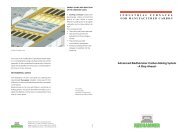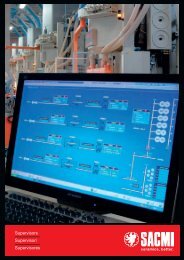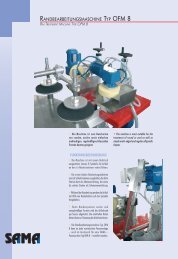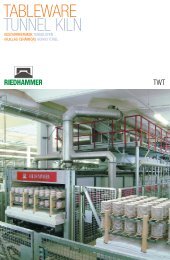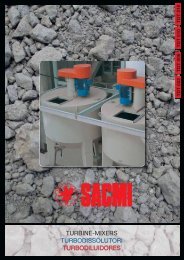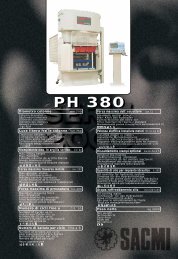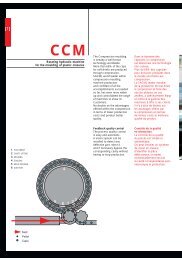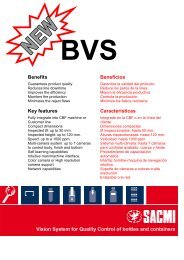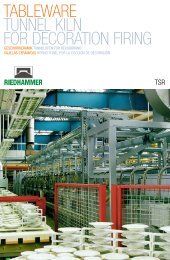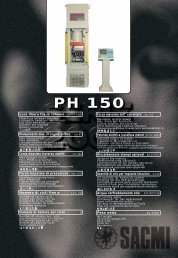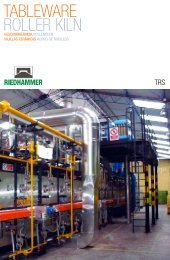Innovative Treatment of Ceramics Using Low O2 ... - Sacmi
Innovative Treatment of Ceramics Using Low O2 ... - Sacmi
Innovative Treatment of Ceramics Using Low O2 ... - Sacmi
You also want an ePaper? Increase the reach of your titles
YUMPU automatically turns print PDFs into web optimized ePapers that Google loves.
ing is realised within 4 to 8 hours. The desired<br />
colour and thus quality <strong>of</strong> the porcelain products<br />
is adjusted and supervised by ensuring a nearstoichiometric,<br />
but reducing firing atmosphere<br />
(air factor λ ≈ 0.95) in the temperature range <strong>of</strong><br />
approx. 1100 °C to 1400 °C. The quality <strong>of</strong> electrotechnical<br />
porcelain, such as high-voltage insulators,<br />
is influenced in like manner.<br />
The thermal treatment <strong>of</strong> bulk solids under certain<br />
oxygen-deficient conditions can also be<br />
carried out in indirectly heated rotary kilns<br />
equipped with special sealings (Fig. 3) and with<br />
an appropriate lance technology for purging<br />
their kiln room e.g. with inert gases.<br />
For larger production capacities <strong>of</strong> s<strong>of</strong>t ferrites,<br />
electrically heated, gas-tight roller kilns and particularly<br />
gas-tight pusher-type kilns with tray<br />
conveyance are the perfect choice.<br />
The magnetic properties <strong>of</strong> s<strong>of</strong>t ferrites are obtained<br />
by a very quick change from near atmosphere<br />
conditions to oxygen ranges <strong>of</strong> up to<br />
30 ppm. This change <strong>of</strong> atmosphere is necessary<br />
between soaking time at maximum temperature<br />
and below Curie temperature. Depending on the<br />
product, however, different oxygen contents<br />
must already be maintained in the heating-up<br />
phase.<br />
products. The burning <strong>of</strong> carbon can be prevented<br />
only if no oxygen and, according to the<br />
Boudouard equilibrium, no CO 2<br />
gas comes into<br />
contact with the carbon products during the<br />
baking process. The typical production plant is<br />
the ring pit furnace for baking anodes and cathodes.<br />
This quasi-continuous plant consists <strong>of</strong><br />
individual sections filled with products and intermediate<br />
channels <strong>of</strong> ceramic pit bricks. A<br />
Fig. 4 • Two electrically heated gas-tight top-hat<br />
kilns<br />
burner ramp “moves” at a periodic interval <strong>of</strong><br />
26–32 h from one section to the next one. Its<br />
burners produce waste gases which are led<br />
through the channels, thereby ensuring the<br />
indir ect heat transfer. Before each section is<br />
closed, the product is completely packed in coke<br />
to make sure that no oxygen can penetrate.<br />
the lower explosive limit (LEL) – up to the upper<br />
explosive limit (UEL) <strong>of</strong> 73 %. The following<br />
explosion prevention representation refers to the<br />
ternary system <strong>of</strong> methanal, nitrogen and air as<br />
an example (Fig. 5).<br />
The vertices <strong>of</strong> the three axes with a scale division<br />
<strong>of</strong> 0–100% each define the initial state <strong>of</strong> a<br />
pure component. In order to assign points in the<br />
ternary system clearly to the percentages, the<br />
reference axes are to be displaced until they meet<br />
the required concentration point. The three concentration<br />
values <strong>of</strong> the substances together<br />
must always add up to 100 %. To ascertain the<br />
concentration <strong>of</strong> one point, the graphic determination<br />
<strong>of</strong> the percentages <strong>of</strong> two components is<br />
sufficient, the third one can be calculated on this<br />
basis. The LEL indicates the minimum percentage<br />
<strong>of</strong> combustible gas in the substance mixture<br />
necessary for an explosion. Under the LEL, no<br />
explosion is possible as the existing concentration<br />
<strong>of</strong> the combustible substance is too low. The<br />
UEL indicates the maximum possible percentage<br />
<strong>of</strong> combustibles in the substance mixture for an<br />
5 The new low O 2<br />
technology<br />
Fig. 3 • Indirectly heated rotary kiln with atmosphere<br />
control<br />
Roller kilns and pusher-type kilns with tray conveyance<br />
are also used for manufacturing other<br />
electronic ceramics products and ceramic diesel<br />
particulate filters.<br />
For smaller production capacities <strong>of</strong> s<strong>of</strong>t ferrites<br />
intermittent kiln plants are sufficient. The production<br />
unit most frequently used for this purpose<br />
is the electrically heated gas-tight top-hat<br />
kiln (Fig. 4), which also achieves the low oxygen<br />
values mentioned above.<br />
Another example among the large number <strong>of</strong><br />
well-known applications <strong>of</strong> thermal treatment at<br />
low oxygen content is the production <strong>of</strong> carbon<br />
The new low O 2<br />
technology for innovative heat<br />
treatment plants with integrated debinding process<br />
differs from the described plants mainly in<br />
terms <strong>of</strong> process engineering.<br />
The new low O 2<br />
technology is a thermal process<br />
technology achieving the shortest, energetically<br />
most efficient thermal treatment <strong>of</strong> high-quality<br />
ceramic products under near-stoichiometric<br />
combustion. A closer examination <strong>of</strong> the debinding<br />
process shows that the most important control<br />
variable is the dependence <strong>of</strong> this process on<br />
the oxygen content and the reaction intensity.<br />
Even if the concentrations <strong>of</strong> the gaseous debinding<br />
products are in the non-hazardous ppm<br />
range in all cases known up to now, the debinding<br />
reactions must be determined for the new<br />
low O 2<br />
technology, and the possible concentrations<br />
during the debinding process must be calculated<br />
in order to prevent deflagrations.<br />
As shown in Tables 1, 2 and 3, the main substance<br />
released during the debinding process is<br />
formaldehyde, also called methanal. The gases<br />
are explosive in a gas-air mixture <strong>of</strong> from 7 % –<br />
Fig. 5 • Ternary system methanal-nitrogen-air<br />
1 = explosive mixture<br />
2 = inert mixture<br />
3 = safe mixture with variable oxygen concentrations<br />
ignition. Above the UEL an explosion is not possible<br />
either, as the existing concentration <strong>of</strong> an<br />
oxidant, mostly oxygen, is too low. Between the<br />
LEL and the UEL an explosion must be expected<br />
if an ignition source exists. The limits are drawn<br />
in Fig. 5.<br />
The LEL and the UEL can be calculated with<br />
corresponding formulae [5]. To fix an explosive<br />
range, another third point limiting the explosive<br />
range is required. This point is calculated with<br />
Vol. 58 (2009) [1] 13



